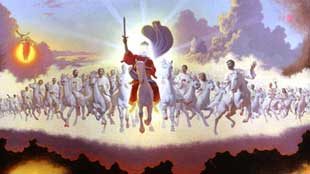
In Revelation 1:11, John is commanded to "write on a scroll what you see and send it to the seven churches: to Ephesus, Smyrna, Pergamum, Thyatira, Sardis, Philadelphia and Laodicea". In Old Testament prophecy, a scroll is symbolic of the delivery of an instruction or a directive from God via a messenger or prophet, so we must interpret them as an instruction or a directive from God via his messenger, John, to the seven churches.
The stucture of the Book of Revelation and the way the letters are written indicates the Seven Letters to the Seven Churches are not part of the "Revelation" but simply identify to whom the Revelation is given. All the "Sevens" are for the benefit and knowledge of all the churches, though specific "seals, trumpets and bowls" do seem to relate directly to that specifically numbered church.
At the time of writing, churches would have existed in those towns and would have all been pioneered by Paul and visited by him at some later stage. As the seven churches are the first in the series of sevens, and indeed all aspects of the book's message are presented in sevens, it is more than likely that the seven churches are also symbolic, in which case they would be symbolic of churches in general, or more specifically, Chirst's followers who worshipped and fellowship together as a church. Therefore, the state of the seven churches and the instruction God gives to each should relate to the seven steps or stages through which followers of Christ must pass on their way to divine completeness. They do.
Who is "The Church" to whom the seven letters were written?If our symbolism is correct, the letters to the seven churches will identify the different strengths and imperfections that will be be found in the different eras of the Christian age. They will also give us a template against which we can measure our progress, to see our weaknesses and strengths.
Before we proceed any further, however, it is appropriate to took at the word church, because what the writer of the Book of Revelation referred to as church and what we refer to as church today are two quite different things. The word used in the original Greek manuscripts of the book of Revelation was not "church" but "ecclesia", which means "calling out". In the whole of His ministry, Jesus never used the word church or ecclesia. The English translation of Matthew 16:18 indicates he did, but the word "church" found here correctly translates as "kingly inheritance".
Matthew 17:18 also has Jesus using the word "church" but a more accurate translation here is "major body of people". The term "ecclesia" was coined by Paul or his contemporaries initially as a reference to anyone who had been "called out" from Judaisim and following the Torah, to follow Christ. As people from other faiths became followers of Christ, they too saw themselves as having been called out and adopted the word "ecclesia". The use of the word "church" in the book of Revelations, therefore, is a collective reference by the book's author to all persons who see themselves as having been called out to follow Christ and his teachings.
The word "church" is the Roman translation of the word "ecclesia" and was first used by the Romans who had taken control of the 2nd Century Church. They used the word as a reference to the organisation they established in 177 AD over which they presided. Emperor Constantine legalised the Roman Catholic Church in 313, at which time it became law throughout the Roman Empire that all persons convert to Christianity and join the Roman Catholic Church.
Connecting the Dots: The Seven Parables of JesusBack to the book of Revelation - it is no coincidence that the letters to the Seven Churches in the Book of Revelation shadow the seven parables about the Kingdom of Heaven that Jesus told in Matthew 13. Both seem to map the journey of God's elect people through seven distinct stages or steps (Revelation illustrates them through the Seven Churches; Jesus uses them to describe the Kingdom of Heaven) on the path christians (both collectively as The Church, and individually as followers of Jesus) must and will travel down on their way to divine completeness. Each of the seven parables of Matthew 13 are discussed in this study with the corresponding church era and stages they represent.
Together, the Book of Revelation and the parables of Matthew 13 reveal themselves to be a step by step guide to divine completeness, documenting the detailed stages through which the followers of Jesus must pass through (illustrated by the seven churches), what they will encounter during each stage (the seven seals), the message God would have us hear at the beginning of each stage to see us through it (the seven trumpets) and the consequences of not following his advice and direction through each stage (the seven bowls).
Chapter 5: The Letters to The Seven ChurchesDesign by W3layouts